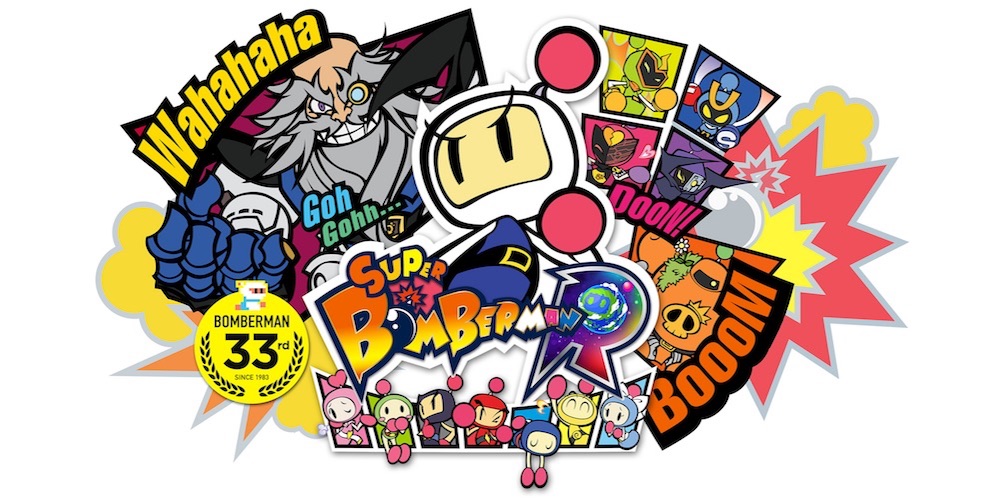
2017 is shaping up to be a fantastic year for gaming, with some of the best titles I’ve played in recent years marching out within the first three months. Wonderful titles like Horizon: Zero Dawn, NieR: Automata, LoZ: Breath of the Wild, Torment: Tides of Numenera, to name a few, and probably a few other subtitled games that I’ve missed, as well. I was beginning to worry that I wouldn’t get a chance to lambast anything this year but blow me down if Konami hasn’t come to my rescue with Super Bomberman R. Not content with just delivering a mediocre Bomberman title, Konami dug into the series’ past to find the bones of Super Bomberman 2 (SB2.) Personally, I was excited when I discovered it would be a continuation of that game but, in the end, it serves to show that Konami only knows what a good game is, not how to actually make one anymore.

Pictured: A dramatisation of the development team’s everyday activities, probably.
With the animation and writing style employed, it could be argued that Bomberman R was intended as a kids’ game and shouldn’t be taken too seriously. That said, I would argue that kids are still discerning enough that even the most vacant-minded child would disregard it as trite garbage. As mentioned, the Five Dastardly Bombers from Super Bomberman 2 return, this time lead by Dr Buggler and his Buggler Army, all of whom are bent on destroying the universe. Buggler. Again, I know it’s not meant to be on the level of F. Scott Fitzgerald but Buggler? Also, instead of being the aliens that they once were, and Bomberman being a literal man who uses bombs, both he and the Dastardly Bombers are all robots in a plot point that gets raised once to very little effect.
For a story mode that could be finished in just a few short hours, it is astonishingly full of non-sequiturs, plot holes, and ideas that just go nowhere. SB2 barely had a story, and it still managed to be more engaging that Bomberman R. Of the eight Bomberman available, half are female, yet they’re collectively referred to as the “Bomberman Bros.” And, of course, they’re a family, with personalities stripped right from 90’s Saturday morning cartoon archetypes. Bomberman R’s idea of ‘humour’ is what you’d get if forced a robot to sit through six hours of Three Stooges episodes and cat torture videos mixed together, then asked it to tell a joke. Honestly, with how bad the whole narrative was, it would have been better to leave it intentionally vague like SB2 was, and refocus efforts on the gameplay and design. Without spoilers, the ending certainly suggests there’ll be a direct sequel, which may be the biggest crime of all.

Most bad games make you cringe from the awkwardness of it all. Bomberman R just made me feel pity.
Bomberman R returns to the “classic” form of the series, favouring a maze-like, grid-style map over an open landscape. Traditionally, this is done with a three-quarter view of the level, with the camera zoomed into Bomberman’s immediate area and then scrolling around as needed. Bomberman R, however, uses a sort of isometric version of the three-quarter view that makes everything look confusing as hell. The camera does kind of follow you around, zooming in and out to adjust to where you’re moving, but does so in a manner that suggests the camera is being held by someone with severe Parkinson’s. Sometimes it’s so far out that level details are difficult to make out, and other times it’s close enough that the HUD obscures areas it really shouldn’t be.
Aside from using the same colour palette, world levels don’t generally have any sense of thematic consistency in their design. Instead, there’s a handful of mission types (like, four) that get thrown in randomly, with the most prevalent and common being “destroy all the enemies.” Somehow, they even managed to squeeze escort missions in there, and I’m stunned with amazement that they resisted QTE’s. Following the setup of its predecessor, each world runs through eight levels of some randomly cobbled combination of the above, with the last being a boss fight. First, you fight against their bomber form, and then against their Bomber-mech form. Neither of these forms are particularly inspired for any of the bosses, though they’re often extremely frustrating in execution. Overall, it’s a design that might have been considered brilliant in 1996.

Pundits from yesteryear’s grandfather are absolutely beside themselves with awe.
With all that in mind, I’m sure by now you can already imagine what playing the game is actually like but let me break it down for you anyway. To call it an exercise in banality would be to harshly disregard all the redemptive qualities that boredom can possess. There’s no pattern, consistent design themes, or anything that speaks to an imaginative approach to how players might engage with the game. The best that the game can boast is that every world has a “unique” environment gimmick, the only noticeable one among those being the ice world that employs the “slip’n’slide” mechanic. You know, the kind of design that says once you step onto the ice in a particular direction, you’ll continue to slide in that direction until stopped by an obstacle? I’ve seen this mechanic used to great effect in many games before, and Bomberman R is certainly not among those.
This uninspired environment design is applied to the same level types world in, world out. The biggest, perhaps the only highlight among them was the exasperated feeling I was left with after seeing that escort missions had somehow been squeezed into the mission types in a Bomberman game. First phase boss levels, fighting against just the enemy Bombers themselves, are so ridiculously cheap that the only way to beat them is to ironically become a suicide bomber. The second phase boss battles, against the Bomber-mech things, flagrantly ignore the game’s own design rules. Bombs and Bombermen move and explode using the 4-directional grid that the series is classically known for, however, Bomber-mechs do not. They have the full range of movement expected from a 3D platform game, which makes hitting them incredibly difficult, and taking damage an inevitability.

I suppose that, with practice, one could master the mechanics of this game but… Why would you bother?
You might be wondering why I’m spending so long talking about the campaign if it’s so wholly unremarkable, and not focusing on the multiplayer, which the series is arguably better known for. Well, that’s because the multiplayer, while lacking a lot of the perspective and mechanic issues of the campaign, is also fairly plain, and shoddily implemented. It does nothing to take advantage of the 33 years of the series’ history, taking the very base mechanics and calling it “good enough.” The best levels are locked off behind pay-walls using in-game currency, which can only be obtained by replaying the campaign. So, sure, the multiplayer does use the three-quarter view that actually works for this style of Bomberman game, and doesn’t have a camera zoom that’s perpetually in motion and handled by Michael J Fox. The only other good thing that can be said about it, however, is that it works.
That 33 years is important to remember, as well, since Konami is apparently so proud of the series’ lifespan that Bomberman R has been produced to commemorate this perculiar milestone. “33rd Anniversary” is proudly emblazoned on the box cover, ironically emphasising the fact that Konami had no interest in reflecting on all those years of the franchise while developing the game. Previous Bomberman games have introduced some excellent design concepts that are totally absent from this game. Remote Control, Pass-through, Land Mine and Power bomb types, for instance, or ride-on campanions with their own abilities, as well as a slew of extra, varied power ups. This kind of stuff is all absent from Bomberman R and, in fact, anything that might resemble innovation on old ideas. Bomberman R brings nothing new to the table in terms of how the game plays, and that honestly makes me sad.

If for no other reason than I paid for this, and at AAA release prices no less.
In terms of how the game looks, the art style undeniably fits with the established look of Bomberman, resisting the temptating to “update” things a la Bomberman: Act Zero. It’s difficult to appreciate in the single player but the multiplayer at least demonstrates that the game doesn’t look terrible. The cutscenes are also beautifully illustrated and animated, befitting the series’ cartoonish style and probably one of the only things Bomberman R got right. If there were a decent story and good voice acting to accompany them then they might have been enjoyable, as opposed to outright terrible. Every line of dialogue sounds like the first reading from the voice actors was taken as the last, with the kind of delivery I’d expect from the early Playstation era. I won’t even get ito the music; I wouldn’t even be able to hum a single bar from the game’s soundtrack, it was that forgettable.

As a series, Bomberman has its bad entries but is otherwise considered to be among the ranks of gaming classics. Super Bomberman R spits on that as one of the undeniably worst entries in the series, taking into account the time at which it was released and what came before it. As a “celebration” of 33 years of the franchise, it does sweet bugger all to actually encapsulate what has made the series good. Whether it be uninspired design, the most standard mechanics of the series with no innovation, and a lame attempt at including a story, Bomberman R is not short in ways to disappoint long-time fans. I find it incredibly difficult to believe that anything remotely resembling pride was involved in its development. If this has been a budget, eShop title on release then it might have been forgiveable. However, this was released as a full priced launch title for the Nintendo Switch, and for that I would expect much better than this.











